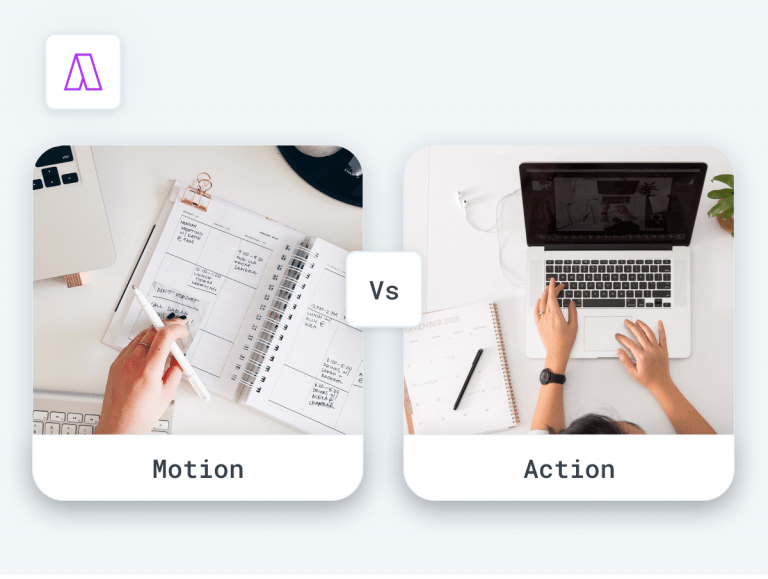Motion Vs. Action: 2 Steps To Improve Productivity
The new year is just around the corner, and you’re once again feeling like you could have accomplished more from this year’s goal list. There is so much you wish you’d done, but at this point, you’ll have to delay it for next year again.
Are you genuinely rolling up your sleeves to get things done, or are you stuck with neverending planning without actually doing it? If the answer is no, it means you’re focusing on motion rather than action.
In a world of delusional perfectionism, it’s easy to get snagged trying to identify the optimal strategy for every little task. We are so preoccupied with finding the right way to do things that we never get around to acting on them.
While running my startup Akiflow, I soon found out that without action, there is no point in strategizing at all. We have only so much time to wait until the perfect conditions arise; imperfect is better than undone in our case.
Here’s how I abide by the theory of motion vs. action and apply it in business.
Motion vs. Action: What’s the difference?
There are two distinct phases to a task: motion and action. While both words may seem like synonyms at first, each has a different impact on the outcome of a project.
Motion means moving, but not necessarily in a specific direction. It’s related to planning, brainstorming, thinking, and preparing for action in any way. When you’re in motion, you strategize, make plans, research, and learn. These activities are obviously important but don’t produce tangible results.
On the other hand, action is about putting your ideas into practice, no matter how good or bad they are. It’s about taking concrete steps toward your goals, often starting before you feel ready because you can always pivot later on. Action requires committing to a task and getting it done.
As children, we learn that planning something before taking action is much more efficient. When writing an essay, for example, we plan the structure (motion) and then get to the writing (action).
But in the real world, the ideal ratio between motion and action is 1/10. Planning can be helpful if it doesn’t become an excuse for inaction. And that’s precisely what happens when we get too obsessed about finding the best solution for each problem we face. So, both moments should have their own dedicated time.
Why excessive motion can lead to procrastination
We have a lot of worries when it comes to taking action. What if we take action, but it doesn’t work out? Such concern can get us stuck in motion and pivot an endless cycle of procrastination.
In his book “Atomic Habits,” James Clear gives the example of a person who spends all day planning to go to the gym but never actually goes. The person wakes up, checks the weather, lays out their gym clothes, prepares their workout bag, and tells themselves they’ll go after work. But then, when the time comes, they find a million excuses not to go. In the end, they never leave the house.
Now, if this person had gone to the gym first and then planned their next workout while they were there, their chances of going to the gym again would be much higher.
This is what motion without action looks like.
It gives the impression that you are getting things done. It’s comforting to stay in motion and convince yourself that you’re making progress. But in reality, you’re merely getting ready to do something.
When planning becomes a tool of procrastination, you must make a change.
Personally, I feel better about a situation where I’ve failed while trying than by not trying at all. It all comes down to this: if you want to achieve something, you must take concrete steps to make it happen. And the sooner you start, the better.
While planning helps you to be purposeful, you will only build something if you get those plans off the paper.
How to balance your time between action and motion
In nowadays workspace, it’s way too easy to keep falling back into motion. Dedicating some time in the morning to establish a strategy and implement it during the day can be challenging, with new emails, messages, and calls incoming by the minute.
Shifting from action to motion constantly disrupts the flow and consumes a lot of energy, making it difficult to go on to the next task.
Now, while action should be your main goal, motion also has its value. Sometimes, sparing time to build an initial plan can save you from stress and increase the chances of positive outcomes.
In fact, most circumstances call for both motion and action. The key here is finding a balance between them.
My go-to tool to find my balance is time blocking. Here’s how I do it:
1. Setting time for motion and action.
As an entrepreneur, I have to deal with plenty of strategic tasks and meetings daily, so I have to make sure that such assignments won’t eat up my whole schedule. To guarantee that, I block a slot in my calendar to review my daily plan, check my email inbox, and deal with any other administrative tasks critical to my upcoming actions.
The same goes for action. Instead of tackling my tasks by chance, I schedule a specific time to execute each one of them. It’s not time for planning; it’s time for doing.
I use Akiflow to set recurring tasks for both motion and action tasks and block my calendar during focus times so that no one can schedule on top of them or disturb me during those.
2. Micro-tasking.
It’s easier to switch back to motion when we’re unsure what to act next. So, I use my motion time to split a task or project into several sub-tasks and ensure I know the next step during my action time.
3. Minding my energy.
The productivity #1 killer is trying to do something at the wrong time. The motion may require a lot of brain energy and focus, and you want to consider your energy level when you plan a “motion” slot, such as early in the week or in the morning.
I leave my action time, which usually consists of more dynamic tasks, for periods when I know I would get bored and distracted more easily.
4. Setting a date to transition from motion to action.
Some goals won’t work as well with the daily or weekly time-blocking approach, particularly those that will only happen once. These things usually need more forethought and a lot of action for execution.
In such cases, I use James Clear’s advice to choose a date to switch between motion to action. I’ll have until that X in the calendar to finish all the planning and start executing. Deadlines are powerful.
My take on motion vs. action
There is no doubt that most situations need some doses of motion and action, sometimes more of one than the other. But especially in the business world, you’ll sometimes have to go for it and deal with the results instead of overthinking beforehand.
With balance, both movements can be optimally implemented in an entrepreneur’s schedule and improve the outcomes of every project and goal. My take on motion vs. action is that done is better than perfect, even if it means adjusting the trajectory along the way.

How To Manage Time Blindness
Explore five effective tactics to conquer time blindness, a common challenge affecting time perception and management. Learn practical strategies for enhancing productivity and achieving a more organized, time-conscious lifestyle.

Dawn of Success: Crafting Effective Morning Rituals
Explore the transformative power of morning rituals in ‘Dawn of Success., and discover how effective morning routines can boost productivity, enhance well-being, and set the stage for daily achievements

12 Best Google Calendar Alternatives
Explore the top 12 Google Calendar alternatives to boost your productivity and streamline your scheduling. Check the diverse options catering to different needs and find the perfect calendar app for you.
